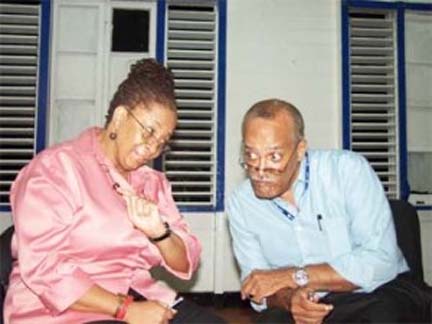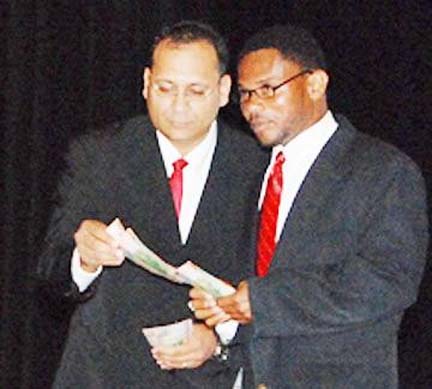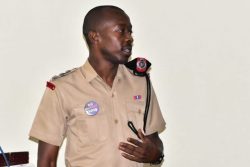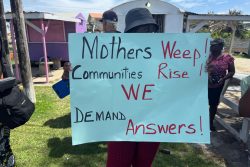 First above all others was the event of the decade, the staging of Carifesta X, which was significant for both local and regional theatre. Apart from the fact of the festival itself, about which a great deal has been said, there was the welcome return to prominence of dramatic plays. After a while participating territories in Carifesta relaxed in the important place they accorded the festival and ceased to send their best artistic products to represent them. In 1995 the signs were there, and apart from the Jamaican play Ecstasy, it was becoming obvious that Carifesta would no longer be the place to see the leading theatre in the region.
First above all others was the event of the decade, the staging of Carifesta X, which was significant for both local and regional theatre. Apart from the fact of the festival itself, about which a great deal has been said, there was the welcome return to prominence of dramatic plays. After a while participating territories in Carifesta relaxed in the important place they accorded the festival and ceased to send their best artistic products to represent them. In 1995 the signs were there, and apart from the Jamaican play Ecstasy, it was becoming obvious that Carifesta would no longer be the place to see the leading theatre in the region.

Certainly in 2000, 2003 and 2006 there was no major theatre and definitely no full-length drama. This resulted from official attitudes on the part of some nations, but it might also have been a development from the rapid increase in the commercial and professional theatre in the region. In earlier Carifestas producers, playwrights, directors, actors and crew were not paid for their work in the festival. But with the rise of the cultural industry it became much more expensive and sometimes difficult to negotiate to get the leading companies and the leading plays which look to the box office for income and financing.

However, in Guyana in 2008 the trend was reversed. A number of territories sent their foremost drama, in some cases this represented the best contemporary artistic efforts on stage at the time, like Rawle Gibbons’ Ogun Iyaan of Trinidad, and even some of the most highly demanded popular plays like Oliver Samuels’ River Bottom and Patrick Brown’s Love Games, both of Jamaica. Most played to full houses in the festival, in direct contrast to what happened in 2006. So that was a positive gain for drama.
Outside of Carifesta, the two leading Guyanese plays of 2008 were Miriamy directed by Ron Robinson and Testament by Paloma Mohamed. Miriamy remains one of the classics of Caribbean comedy, a play by Frank Pilgrim that arose from the newly established Theatre Guild in 1963. After initiations by Norman Cameron it was Pilgrim and Sheik Sadeek out of the same Guild who set local Guyanese drama on its way in the 1960s. Francis Q Farrier was to follow. Miriamy went on to become acclaimed in the region and Robinson’s production was the most recent revival of it on stage. It was a successful revival that made a mark as a leader on the local stage that will be remembered.
Testament was dramatized for the stage by Mohamed as a dramatic adaptation of a publication by Janice Imhoff, which documented the experiences of a number of women who celebrated their survival and conquest over cancer. Gem Madhoo-Nascimento saw the theatrical possibilities and searched for a dramatist to write the script. Dr Mohamed is the playwright who eventually did it and titled it Testament. It is a documentary on cancer in women with educational value, but it is also a remarkable piece of theatre. It uses some echoes of mediaeval drama, monologues and images to fashion a work that stood out as a leader on the local stage for 2008.
Madhoo-Nascimento’s GEMS Theatre Productions was also responsible for another important performance in the Guyanese theatre of 2008. This was performed on the Pre-Carifesta ‘Fringe’ and brought back on stage one of the legends among Guyanese performers. Dave Martins became famous around the Caribbean as the leader of The Tradewinds and his show in Georgetown was not only a return home, but a return to an old brand of theatre tradition which has contributed to Martins’ new performance shape. It is a tradition in which Dem Two has worked, and one which opened a gateway for Paul Keens Douglas and Oliver Samuels. What was important about Martins’ return is that he brought with him a brand of stand-up comedy which did not just generate nostalgia, but created a form that suited the composer, musician, humourist and social commentator.
As it happened, 2009 also marked another very important return within the same kind of theatrical shape as the one adopted by Martins. Ken Corsbie was the originator of the famous Dem Two who popularised theatre in that tradition in the seventies. Since then he worked in film, but more prominently as one of Barbados’ leading directors and in stand-up comedy. But he also brought something very special and peculiar to that art which came out of the kind of total theatre package found in Dem Two’s successor, All Ah We. Corsbie tried to recreate that on stage with Ron Robinson, Francis Farrier, Russell Lancaster, Mariatha Causeway (Jennifer Thomas) and his only available partner from that group, Cammo Williams. The performance was important because of the flame it relit in an effort to keep that form of theatre ablaze.
Another theatrical type that took command and embossed its dominance on the local 2009 stage was the Link Show. After a shaky period and a worrying absence, this annual comic series returned in an explosion of glory to be a signal event in 2009. Director Ron Robinson and Madhoo-Nascimento, his former co-producer, worked together again as The Theatre Company, and GEMS Theatre teamed up to present what must have been the best of all the 25 Link Shows.
Link Show 25 was what all its predecessors wanted to be – a masterpiece of theatrical satire in the form of a satirical revue of social and political commentary. It succeeded in all respects as an excellent performance of different types of dramatic pieces, including some well-written skits, the use of dance, video and multi-media. The Link was already known as the most popular production on the Guyanese stage, but in 2009 it deservedly kept bringing the audiences back in an extended run. The clichéd and commercially exploited phrase, “back by popular demand” was this time truly appropriate as an expression of audience appreciation for the dramatic production of the year.
Another of the outstanding productions of 2009 stood out because it had the distinction of transcending dance into drama and presented to the Guyanese public a memorable brand of theatre. Ramlila was the kind of success its creators had been working towards in a number of other productions that tried to present dance drama, or used dance to carry a dramatic story line. A series of presentations of Naya Zamana had modelled themselves on Bollywood film, but Ramlila rekindled an ancient theatrical dance tradition that is a part of the Indian heritage in the Caribbean.
It was performed by the Nritya Sangh of the Guyana Hindu Dharmic Sabha directed by Vindhya Persaud. It was the best production, the most polished and accomplished performance by this group since it began major public dance productions. It was a crowning achievement for Dr Persaud, establishing her as a serious theatre director and one of the major choreographers of the country. Ramlila was also choreographed by Trishala Persaud. This was also a significant revival of a centuries-old Hindu tradition which was brought to Guyana but faded away years ago. The production was therefore important as Hindu dance drama, as the restaging of a tradition and as an excellent production.
There were also other stage performances of Indian theatre worth documenting, such as Neaz Subhan’s productions which converted Indian films into stage plays, Baghban performed in 2009 being one example. Another similar effort was the Indian play Kanyadaan done in 2008. Apart from their very important themes and messages they presented the return to the Guyanese stage of Mahadeo Shivraj who was in both, and Richard Naraine whose masterful performance in Baghban was one of his best in recent appearances.
There is also much to be said about a new company that emerged in 2009. Apsara, with choreographers and specialists like Chandini Ramnarain and Marcia Akeong, moved from Indian dance to make a good impression in other modern forms, joining the best local companies like the National Dance Company, the Nritya Sangh, the National School of Dance, the Nadira and Indranie Shah Dance Troupe and the Indian Cultural Centre. But this was about drama. The dance in 2008 and 2009 tells its own tales of achievement.









